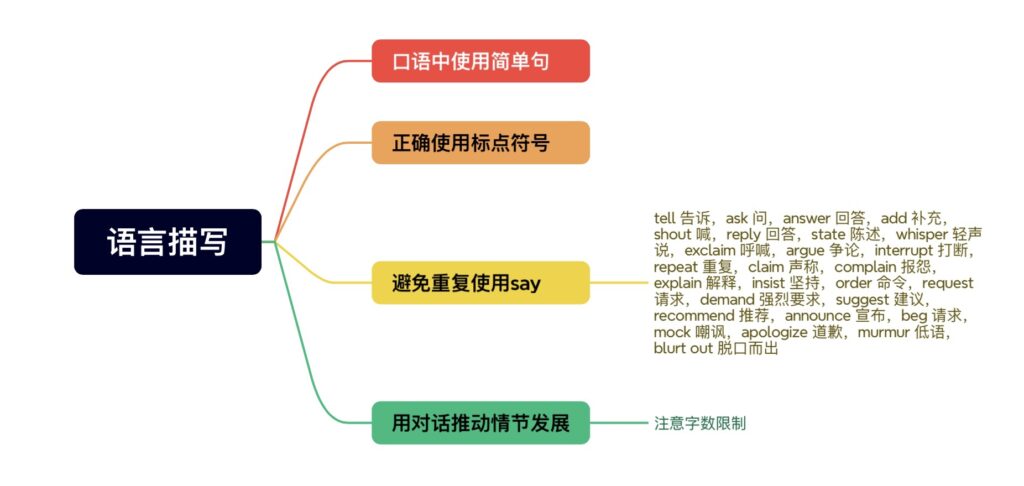口语中的简单句
日常的对话多使用简单句,并不会像书面语那么冗长复杂,如下面这段对话:
-“Hey, girl, you want to have noodles ?”
-“Oh, yes, but I have no money on me”she replied.
-“Oh, that’s nothing. I’ll treat you today,”the owner said,“come in.”
而且,在长句中插人简短的语言描写,可以改变文字的节奏,使其更有韵律感。
正确使用标点符号
(1)说话人+说话内容
“说”后用逗号,引号内第一个字母大写,句尾标点符号放在引号内。
如:He said,“You are my best friend!”
(2)说话内容+说话人
陈述句引号内用逗号,引号外第一个字母小写;疑问句或感叹句引号内用问号或感叹号,引号外第一个字母小写。且“某人说”可以写作“sb.said”也可以写作“said sb.”。
“Yes,” he said.
②“You may both go,” said Pa.
③“Don’t move,” she said to William in a soft voice.
(3)说话内容+说话人+说话内容
“某人说”可以写作“sb.said”也可以写作“said sb.”;“某人说”前面引号内用逗号,
引号外第一个字母小写。“某人说”后面如果用句号;则后面引号内第一个字母大写;“某人说”
后面如果用逗号,则后面引号内第一个字母小写。
①“That’s cool,” he said.“Can I have a try?’
②“You’d better let me go,”teased her twin brother,William.“There are dangers all over
this prairie.”
③“You can go any place you want,”Beto said,“but I think youll find what you need.”
避免重复使用say
如果续写中语言描写较多,那么一定要避免通篇都是“said”,而要灵活多变地使用表示“说”
的动词,比如以下这两个例子:
例1: I laughed,“There’s no way! I’m 55!” But he persisted, and before I knew what I had done, I was enrolled for classes in English and crafts. “This is only an experiment,” I warned him, but he just smiled.
翻译:我笑道:“没办法!我55岁了!”但他很坚持,在我还不知道自己做了什么之前,就报名参加了英语和手工艺课。“这只是一个实验,”我警告他,但他只是笑了。
例2:“What is the matter now?” asked his wife. “I just can’t remember why I come back and where I am supposed to be going on such a hot summer day” replied the professor. However, the real reason was that he forgot where he had left his children. Sensing something wrong, Mrs. Smith didn’t believe his words, because whenever he told a lie he would usually blink his eyes quickly. “Tell me the truth,” ordered his wife. “As you told me, I didn’t forget where I put the name of that town, but I forget the station where I left our children!” whispered the professor, his voice trembling. “What a bad memory!” shouted his wife.
翻译:“现在怎么了?”他的妻子问道。“我只是记不清我为什么回来,也不知道我在这么炎热的夏天应该去哪里。”教授回答道。然而,真正的原因是他忘了把孩子们留在哪里了。Smith太太觉察到有什么不对劲,她不太相信他的话,因为每当他说谎,他通常会快速地眨眼。“告诉我真相。”他的妻子命令道。“正如你告诉我的,我没有忘记我把那个城镇的名字放在哪里,但我忘了我把孩子们留在哪个车站了!”教授声音颤抖着低声说。“记性真差!” 他的妻子喊道。
以下列举一些续写中可能用到的关于“说”的表述范例:
tell 告诉,ask 问,answer 回答,add 补充,shout 喊,reply 回答,state 陈述,whisper 轻声说,exclaim 呼喊,argue 争论,interrupt 打断,repeat 重复,claim 声称,complain 报怨,explain 解释,insist 坚持,order 命令,request 请求,demand 强烈要求,suggest 建议,recommend 推荐,announce 宣布,beg 请求,mock 嘲讽,apologize 道歉,murmur 低语,blurt out 脱口而出
例1:“Christine! Take care of your young brother!” Mother shouted at the top of her voice.
翻译:“Christine!照顾好你弟弟!”母亲高声喊道。
例2:“Hannah? You know where she is? How is she? Please tell me,”he begged.
翻译:“Hannah?你知道她在哪儿吗?她怎么样?请告诉我。”他恳求道。
例3:“Did you go skating a lot last year?” I asked, blurting out the first thing that came to my mind.
翻译:“你去年经常溜冰吗?”我问,脱口说出出现在我脑海里的第一件事。
例4:One morning, when she was working with Bella, I heard a tiny voice barely a whisper, “Good dog.”
翻译:一天早上,当她和Bella一起工作时,我听到一个很小的声音,几乎是耳语,“好样的。”
例5:“There’s a Christmas wish contest on the newspaper” Amy’s mom announced. “Write a letter to Santa, and you might win a prize.”
翻译:“报纸上有一个圣诞愿望竞赛。”Amy的妈妈宣布,“给圣诞老人写封信可能会得奖。”
例6:“I can’t get it out!”I shouted, my voice sounding unnaturally loud in the enclosed space.
翻译:“我拿不出来!”我喊道,我的声音在封闭的空间里听起来很奇响。
例7:She managed a forced smile, murmuring “Thank you, anyway,” and turned toward the doorway.
翻译:她勉强一笑,低声说“无论如何谢谢你”,转身朝门口走去。
用对话推动情节发展
续写中还可以用对话来推动情节的发展,比如下面这个例子:
Suddenly he burst into laughter. “With that gun?” asked the professor. Strangely, he didn’t seem frightened of Carl any more. He continued,“You can’t shoot with that antique gun. You should have put it in the museum actually.” “Is this really an antique gun?” asked Carl. “How much is it worth?” “It was worth about 17,000 dollars,” said the professor. “But now you can get 10 dollars for it.” “Why?” asked Carl. The professor replied“Because you see its end is missing.”
翻译:他突然大笑起来。“用那把枪?”教授问道。奇怪的是,他似乎不再害怕 Carl 了。他接着说:“你不能用那把古董枪射击。你真该把它放在博物馆里。”“这真的是一把古董枪吗?”卡尔问,“值多少钱?“它从前大约值17,000美元,”教授说,“但是现在你可以得到10美元。”“为什么?”Carl 问。教授回答说:“因为,你看,它的末端不见了。”
但是要注意的是,在续写中不能添加过多对话,使用过多的对话,会显得篇幅累赘且很难在限定的词数里把整个后续的情节发展补充完整。
Mindmap解析
